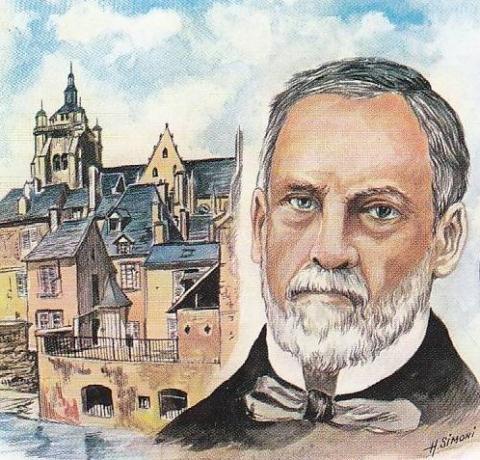-
Table of Contents
- 0. STORY PREFACE
- 1. RABIES - WHAT'S in a NAME?
- 2. RABIES in ANCIENT TIMES
- 3. WHAT IS RABIES?
- 4. LOUIS PASTEUR - EXPERIMENTER
- 5. LOUIS PASTEUR MEETS JOSEPH MEISTER
- 6. A TEEN HERO NAMED JEAN-BAPTISTE JUPILLE
- 7. LOUIS PASTEUR - WORLDWIDE BENEFACTOR
- 8. RABIES as a 21st-CENTURY PROBLEM
- 9. RABIES and ZOMBIES
Louis Pasteur was born in the town of Dole, in the Jura region of France. In this illustration, we see Pasteur and the house where he was born.
By 1885—around seventeen years after Louis Pasteur had suffered a paralytic stroke at the age of 46—he was internationally famous for devising a process to remove bad materials (like bacteria, parasites or viruses) from raw milk. The process is still called “pasteurization,” in his honor.
We learn how the process works (and why it was needed) from the CDC (Centers for Disease Control):
Pasteurization is the process of heating milk to a high enough temperature for a long enough time to kill illness-causing bacteria contained in the milk. As most commonly applied, pasteurization heats milk to a high temperature for a short time, which kills the bacteria that cause illness.
It was invented in a time when millions of people became sick and died of diseases like tuberculosis, scarlet fever, typhoid fever, and other infections that were transmitted through raw milk. Pasteurization has prevented millions of people from becoming ill.
Pasteur came-up with his making-milk-safer idea after thinking about the presence of maggots in decaying meat.
Before Pasteur, people believed in the theory of “spontaneous generation” (where decaying meat spontaneously generates maggots). That concept may have originated with Aristotle—the Greek philosopher who taught Alexander the Great—when he describes both the decay of living things (putrefaction) and the giving-off of gas and heat (fermentation):
Animals and plants come into being in earth and in liquid because there is water in earth, and air in water, and in all air is vital heat, so that in a sense, all things are full of soul (spirit). Therefore, living things form quickly whenever this air and vital heat are enclosed in anything. When they are so enclosed, the corporeal (bodily) liquids being heated, there arises as it were, a frothy bubble. (On the Generation of Animals, by Aristotle and translated by Arthur Platt.)
Pasteur, however, believed there had to be a better explanation for this phenomenon. He did some thinking and testing of his ideas at his lab in Arbois.

The Frenchman discarded the “spontaneous-generation” theory, replacing it with the “germ theory” of disease. In other words, it is germs (and other infectious microbes) which cause meat to decay (not the other way around).
With this concept in mind, Pasteur concluded that harmful microbes in milk were causing people to get sick (when the milk went straight from the cow to the table). His heating process worked to kill the offending microbes, saving people around the world from tainted-milk illnesses.
Having invented a way to make milk safe, and already having invented vaccines for anthrax and chicken cholera, Pasteur revisited his desire to help people who’d been bitten by rabid animals. If there was no cure for rabies, and there was no way to save the lives of symptomatic people, was there at least a way to prevent rabies from fully developing inside the body?
Pasteur looked into the work of a French veterinarian from Lyon named Pierre-Victoire Galtier.
In 1879, he’d reported that rabies could be transmitted from dogs to rabbits. And ... because rabies has a long incubation period from first infection (via animal bite) to onset of symptoms... Galtier believed something could be done to help individuals after the infection entered their bodies (via an animal bite) but before symptoms appeared.
That led Pasteur to think about drying the spinal chords of rabies-infected rabbits. And when he did that, beginning in 1882, he forever changed the world for people infected with the deadly disease.
-
Table of Contents
- 0. STORY PREFACE
- 1. RABIES - WHAT'S in a NAME?
- 2. RABIES in ANCIENT TIMES
- 3. WHAT IS RABIES?
- 4. LOUIS PASTEUR - EXPERIMENTER
- 5. LOUIS PASTEUR MEETS JOSEPH MEISTER
- 6. A TEEN HERO NAMED JEAN-BAPTISTE JUPILLE
- 7. LOUIS PASTEUR - WORLDWIDE BENEFACTOR
- 8. RABIES as a 21st-CENTURY PROBLEM
- 9. RABIES and ZOMBIES
Media Credits
In-text image depicts Pasteur's lab in Arbois, France. Image online via the Pasteur Museum in Arbois.


 Back
Back
 Next Chapter
Next Chapter

 Back
Back
 Next Chapter
Next Chapter
